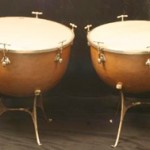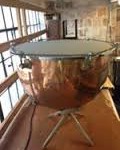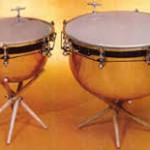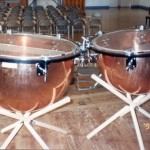My Instruments|Chain and Cable-Tuned Timpani
I have played on pedal-tuned timpani for most of my career, which now spans a forty-year period and have always enjoyed the experience. However, whenever I have had the chance to play on timpani that were either hand-tuned, or equipped with an Anheier-like cable system or a chain system such as that used by Marshall Light, I considered that a red-letter day as it gave the chance to raise my level of knowledge of the instrument as well as gain experience with the instrument.
Hand-Tuned
My first experiences with hand-tuned timpani came when I was still a student at the Manhattan School of Music. I was invited to play timpani with an orchestra sponsored by the Greenwich House Music School and conducted by Michael Bartos. It was a group of about 50 musicians that gathered together once a week to rehearse and put on a concert every so often, with their final concert taking place at New York City’s Town Hall. The regular percussion instructor was Howard Van Hyning, but he was so busy elsewhere that they needed someone to play timpani with the orchestra, and I was the one that was available. The instruments that were available were an old pair of hand-tuned timpani that dated from the very early twentieth century, and were mounted on low iron stands much like those seen in very old photos dating from the period.
They were so low, that I had to sit on a camp chair in order to play them. The drums themselves were tilted upwards and slightly inwards for optimal performance. The heads were clear Remos – and were actually in good shape, due no doubt to Mr.Van Hyning’s skill and care.
I wish I had a picture of those instruments – they were most interesting to play. I learned to be quick with the pitch changes, manipulating the t-handles quickly enough to land on the right notes without much trouble. I played many works on those drums, among them Rimsky-Korsakov’s”:Capriccio Espagnol”; Brahms” Second Symphony; Beethoven’s Third Symphony; Wagner’s Prelude to Act I of “Die Meistersinger”; Schubert’s Third Symphony, among others.
I remember myself rapidly learning where the two most sensitive and clearest spots on the drums were – these would be the tuning handles that I would manipulate most often when there were tuning changes, and still allow for good timpani tone.
The heads on the drums were, oddly enough, clear Remo heads (this was before the era of the “line through the middle”) which actually sounded quite good.
Other than sitting quite low, and having them tilted towards me in a way that I was totally unused to, it was fun playing on those drums Once I did get used to them, I got some pretty good performances out of them. I played on those drums periodically from 1974 up until and including 1977. I remember them with affection. They were a good learning tool for me.
Chain –Tuned Timpani
Ironically, I had had some experience with cable timpani before I played on the Greenwich House hand-tuned timpani. I had auditioned in my junior year at MSM for an orchestra conducted by Meir Wiesel, a conducting student at MSM. The orchestra was a pick-up group that would play run-outs in the New York metropolitan area – in Queens, Staten Island, the Bronx, and out in Jersey. I did well, but another fellow who had his own timpani won the audition.
However, I was runner-up and was the given the opportunity to fill in for him on several occasions. One of these occasions stands out in my mind. It was a run-out concert to a small city in northern New Jersey ( I cannot for the life of me remember where), and the program included Brahms’ First Symphony. A pair of Goodman chain timpani – sizes 25 inch and 28 inch – were provided. They were in good condition, but were old, and the bowls were darkened with age, but they sounded good. The chain mechanism was at the level of the counter hoop, but once I plugged the keys into the sockets of the tuning mechanism, I got used to it quickly, as the mechanism was quite nimble. I was surprised at the quality of the sound ( I normally- even back then – played my Cs and Gs on 28 or 29 inch and 31 or 32 inch timpani) of the Cs and Gs on these two drums – quite big and round. The heads were Remo hazy – pre 1981 – and the concert went off splendidly.
My next opportunity to play on chain drums came when I was a substitute with the National Orchestral Association during the 1975 – 76 season. The orchestra at this time was rehearsing in downtown Manhattan, and a colleague of mine had a set of very good vintage Ludwig Universals as inside drums, with Goodman chain drums on the outside. He equipped these with calf heads – and they were good. I remember playing a couple of movements from Mahler’s Fourth Symphony – and having to change pitch while rolling on the 30 inch drum – which was a chain drum. I remember rolling with one hand – keeping the bounce going – while effecting the change with my other hand on the tuning handle. I had seen Mr. Hinger doing it at the Met on many occasions, so I was confident that it could be done. And I did it, remembering to this day how effortlessly it could be accomplished using good equipment.
Chain – tuned -timpani in Oslo
My next opportunity to play on chain-tuned timpani came about ten years later, after I had assumed the position of principal timpanist in the Oslo Philharmonic. The year was 1986, and we had purchased a pair of Light Metropolitan B pedal timpani as the core of a new second set of timpani to be used for touring and run-outs. I remembered my experience with the Goodman chain drums in the 70s, and convinced the orchestra to purchase a 31 inch Continental Chain timpani from the American Drum Mfg. of of Denver, CO, who also manufactured our Metropolitan Bs. The drum came in to Oslo in late April of 1987, and I unpacked it and set it up on its tripod on the stage of the Oslo Konserthus.
Initially, I was disappointed, not in the mechanics of the drum, but in the tone quality of the Remo head that was on the drum. It was a Remo hazy, with the line down the middle. However, I played on it for an hour, then my colleague played on it while I went out in the hall to listen. My impression changed for the better. Out in the hall is sounded huge – magnificent. I particularly liked the fact that the chain was below the counter hoop and left the playing surface in the clear, reducing the chance of fouling one’s sticks in the mechanism.
With regards to heads on that particular drum – we started out with a Remo Hazy head, which worked fairly well, but I always felt it was a little “hard” sounding. I replaced it in mid 1988 with calfskin, and that made all the difference in the world! A huge sound – it can be heard with calf on the 1992 recording of Dvorak’s Cello Concerto (Truls Mørk, soloist) on Virgin Records; Sibelius’ 3rd Symphony with Mariss Jansons on EMI/Angel; as an extra drum in Respighi’s Feste Romanae, again with Jansons on EMI. Originally mounted on a tripod, we had a special ring stand built for it in 1992, and it sat quite well in the stand and was much easier to move. Because of this ring stand, we were able to take this drum on tour with us.
Cable-tuned Timpani
I had my first introduction to cable-tuned timpani with my first lessons with Fred Hinger. He always had two pedal-tuned- drums on the inside and two cable-tuned drums on the outside. In this case, the cable drums were built by him, to the Anheier design. His 31 inch drums were incredible. With a deep kettle, the sound was well-nigh incredible. I venture to say that it would put some 32 inches to shame – such roundness and depth! His 22 and a half was pretty good too!
My biggest involvement with cable-tuned drums came starting in 1993, when I was awarded a stipend by my chief conductor, Mariss Jansons. The object was to go abroad and sharpen one skills by study with a timpanist of a major orchestra, or just simply attend their concerts and learn by observing. I did a bit of both on that tour, visiting and listing to that great Canadian timpanist, Louis Charbonneau, who was principal timpanist with the Montreal Symphony from 1948 until his retirement in 1998. On the way up to Montreal from New York, where I landed and visited my family, I stopped off in Burlington, Vermont to visit with David Davenport, a friend of mine who was then the percussion instructor and band director at the University of Vermont in Burlington. I had planned to see him as we were at the time looking to work on a timpani book-writing project and needed to see if it would work out. During the visit, we spent a couple of hours on campus looking over Dave’s collection of hand and cable tuned timpani.
They were reconditioned by Brian Stotz and the kettles were redone and looked beautiful!
He had two sets of hand-tuned drums and two sets of Anheier-cable conversions. I was in seventh heaven. He had Remo clear heads on all of them, which is what he preferred. They sounded fantastic. We actually went back a second day to”play around” on them. The reason for this second visit is that at Dave’s home, he had a pair of old Leedy hand-tuned timpani, sizes 25 and 28 inch, which he used for practice at first, but found that he was so busy at school, they were taking up space. I was so enamored of the cable-drums at the school that I thought “I’ll buy these drums and have Brian re-do them as cable drums”. I’d figure out the logistics of getting them to Rochester for conversion and picking them up later. I told Dave that I was interested in buying them with the intent of converting them over to cable, and he was more than supportive. I wound up buying the drums for $350, and Dave most generously took it upon himself to transport the drums to Rochester for me, and got me in contact with Brian Stotz. I handled the paperwork and payment from Norway, and Dave got them to Rochester in good order. The next step was to pick them up. I bought the drums in October 1993 – and Dave took them out to Rochester in the spring of 1994. It turned out that the Oslo Philharmonic was interested in buying a 23 inch cable directly from Brian Stotz, so I’d be picking up three drums instead of two. Since the orchestra was making a US tour in the fall of 1994, it was arranged that we’d have all three drums shipped to Ann Arbor, Michigan, where we had a concert scheduled at Hill Auditorium. Sal Rabbio, then timpanist of the Detroit Symphony and timpani instructor at the University of Michigan was kind enough to have them set up on stage and ready for us.
I could not believe how good they sounded out of the box. I used them that night for the Berlioz’ Symphonie Fantastique, and they were amazing! The sound of the drums was pure and unrestrained, and the mechanisms worked perfectly. We had Premier hazy heads on them – that was what I had ordered from Brian, and I couldn’t have made a better choice. Sal thought the drums sounded very well indeed and congratulated me on a good choice!
Those drums performed magnificently on the tour, and I even attempted Strauss’ Don Quixote as well as the Berlioz at the Kennedy enter concert in DC.
I wish I had more photos of these drums, but unfortunately I don’t. I had the two Leedy-Anheiers from November 1994 until May 1998, when I sold them to avoid the cost of transporting them to America on my own dime when I left Norway. My associate timpanist bought them, as he really liked them.
I used them on many occasions – and recorded Mendelssohn’s “Italian” Symphony with them with the Norwegian Chamber Orchestra under the late Iona Brown for NAIM Records. I also used them as auxiliary instruments – in Mahler 6 under Eliahu Inbal I used the 25 inch as a top drum and I did the same in Nielsen 4 under Berglund. I am glad that I had that experience with these drums. If I had to do anything over again. I would have found a way to hold on to the Leedy-Anheiers and bring them back to the States. Hindsight is better than foresight so they say!





Recent Comments